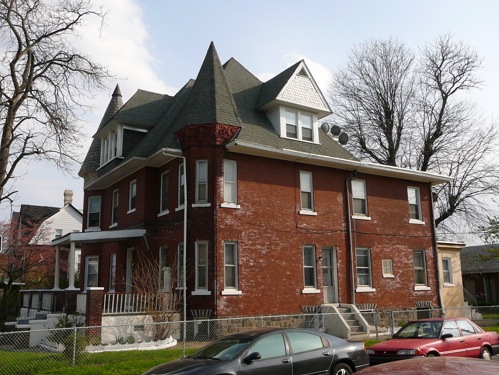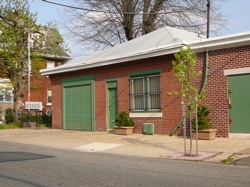
Frank Shuman's Inventors Compound, 1895-1918
4600 Disston Street, Philadelphia PA 19135 (house: southeast corner of Ditman Street).
6913 Ditman Street, Philadelphia PA 19135 (laboratory: behind house).
© Harry C. Silcox, Ed.D.,
Workshop of the World (Oliver Evans Press,
1990).
The home and laboratory of
Frank Shuman, an internationally known inventor, remains
at 4200 Disston Street. It resembles the compounds of the
inventors of the period. Here are the inventor's home,
two houses for relatives and a laboratory. Here Shuman
experimented with wire and safety glass, and developed a
low pressure steam engine for his solar energy plant, as
well as a new method of producing cement pilings for
buildings. He was an officer in the first wire glass
company in the United States and the president of a
safety glass firm. His Simplex Concrete Piling Company,
which specialized in foundations for buildings, was
located at Comly Street below State Road in Wissinoming
on the same site as his American Wire Glass Manufacturing
Company.
Shuman became a wealthy man and his activities made
Tacony a place the inquisitive wished to visit. Tacony's
open fields became the site of the first successful use
of solar energy which produced steam to run an engine.
Two such power plants were built near Shuman's Tacony
home and later sold to the Egyptian government where they
were used to irrigate the desert near the Nile River.
These solar energy experiments made Shuman
world-famous. 1
Shuman died in 1918 in his house on Disston Street. The
compound was later divided and the buildings sold
separately." 2
Shuman's house
has been converted into apartments, and his laboratory is
currently being used as a metal shop.
1 Ken Butti and John
Perlin, A Golden Thread: 2500 Years of Solar Architecture
and Technology, (Palo Alto, 1980), pp. 77-101.
2 Mrs. Marguerite Dorsey
Farley lives in one of the houses; she was born in 1896
and remembers the Shuman family from her childhood.

Update May
2007 (by
Torben Jenk):
The house survives but is in
poor condition. Ten electric meters at the rear suggest
this house has been subdivided into many apartments. Many
of the decorative items have been lost, including the
corner turret, which surely rose atop the curved
decorative brick cornice. The laboratory is in better
condition, with freshly painted doors and millwork. It is
now used by Penn Industrial Installations. A one-story
brick addition has been added to the south side (farther
from the house).